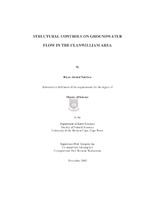Structural controls on groundwater flow in the Clanwilliam area
Abstract
Deformation of the western part of the Table Mountain Group rocks during the Cape Orogeny created a series of folds and associated fractures. The subsequent continental break-up of Gondwana led to the development of large fault systems. These exert a major influence on deep and shallow groundwater flow. There are 3 main types of structures that are investigated. The geological contacts between hydraulically different lithologies, the primary characteristics of the sediments comprising the main geological units and the secondary structures developed from the tectonic events. These inter-alia include lithological boundaries, bedding and conjugate joints and large faults. Compartmentalisation of the aquifers by lithological and fault boundaries are the main regional level controls on flow in the study area. Joints are important for local control of flow, but cumulatively exert a regional effect as well. These controls exert a strong 3 dimensional impact on flow patterns within the area. Geological cross sections and detailed fieldwork combined with the conceptual models proposed are used to determine groundwater flow and the extent of the flow constraints. There is heterogeneity in the fault characteristics whilst there isconsistence in the impermeable aquitards. These effect boundaries at the base of the aquifer, divide the aquifer into upper and lower units and cap the top of the aquifer. Using water level data, EC and pH an attempt is made to establish patterns created by structures, mainly faults. There appears to be some control of these shown by patterns seen on contour plots of the data. Understanding of the structures can significantly alter the way the available data could be interpreted. The integration of all available data into the conceptual model provides an effective research tool, which opens up further avenues for new approaches and methods for continued research in this area.

